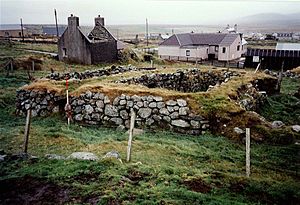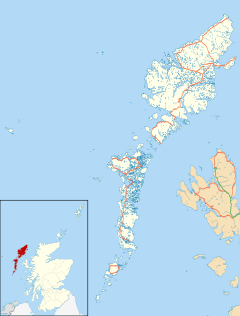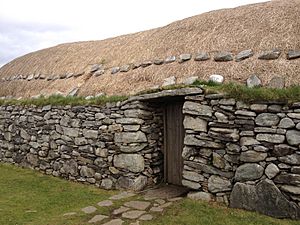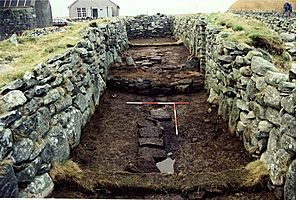Arnol facts for kids
Quick facts for kids Arnol
|
|
|---|---|
 A typical abandoned blackhouse from Arnol |
|
| Language | Scottish Gaelic English |
| OS grid reference | NB311486 |
| Civil parish | |
| Council area | |
| Lieutenancy area | |
| Country | Scotland |
| Sovereign state | United Kingdom |
| Post town | ISLE OF LEWIS |
| Postcode district | HS2 |
| Dialling code | 01851 |
| Police | Northern |
| Fire | Highlands and Islands |
| Ambulance | Scottish |
| EU Parliament | Scotland |
| UK Parliament |
|
| Scottish Parliament |
|
Arnol (called Àrnol in Scottish Gaelic) is a small village in Scotland. It's found on the west coast of the Isle of Lewis, which is part of the Outer Hebrides. Arnol is located along the A858 and is part of the Barvas area.
This village was once a busy place with over forty "crofts." A croft is a small farm, often with a house and some land. Today, Arnol has about 100 people. Fewer people work as crofters now. Arnol is also home to the famous Blackhouse Museum, which is looked after by Historic Environment Scotland.
Contents
Arnol's Past: A Moving Village
The village of Arnol has changed its location at least three times over the last 200 years. When people moved, they often took building materials from old houses to build new ones. In the early 1800s, the village was right by the coast. Later, it moved further inland, closer to the main road.
Most of the buildings that are still standing today were not lived in for more than 50 years. During that time, many of them were changed a lot. They were made bigger, or parts were rebuilt.
The Famous Arnol Blackhouses
As you walk through Arnol, you'll see the remains of many traditional "blackhouses." A blackhouse is a type of old house found in the Scottish Highlands and Islands. Most of them no longer have roofs, but their thick stone walls are very easy to spot. They have a unique, natural look.
Older blackhouses have rounded ends. They often look like several connected rooms. Typically, there was a central area for living and for animals (called a "byre"). There would also be a porch and a barn on either side. Newer blackhouses can be identified by their flat, gabled end walls. They also have a stone wall inside that separates the living area from the byre.
The Blackhouse Museum: No. 42
The museum at No. 42 is a great example of a blackhouse on Lewis. It has been cared for by the state since the last family moved out in the 1960s. This building still has its original inside parts. It gives visitors a very good idea of what it was like to live in a blackhouse long ago.
A fire is always kept burning in the central fireplace. This is very important! The smoke from the fire helps to keep the roof dry and in good condition.
Exploring No. 39: An Excavated Blackhouse
The visitor centre also includes the ruined blackhouse across the road at No. 39. This is one of the few blackhouses on Lewis that archaeologists have studied. Headland Archaeology dug up the site and found different layers of history. These layers showed how the building changed over time. This happened as landowners tried to make living conditions better.
The oldest parts of the house showed an open central fireplace. There was no clear wall separating the living area from the animal byre. In later years, the floors were covered with stones or flat slabs. A step was also built to separate the areas where people lived from where animals stayed. The living area was made level, probably to fit furniture like box beds. Before its roof fell in, the building was used for weaving. This is known because a stone platform, used for weaving, was found in the main room.




